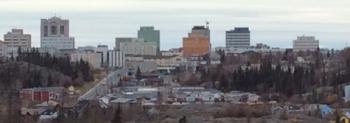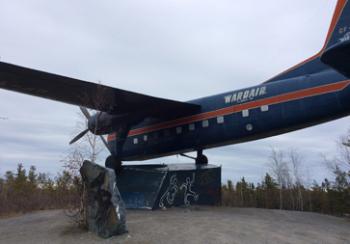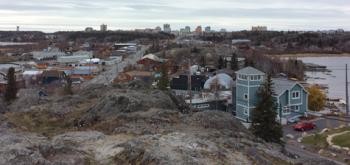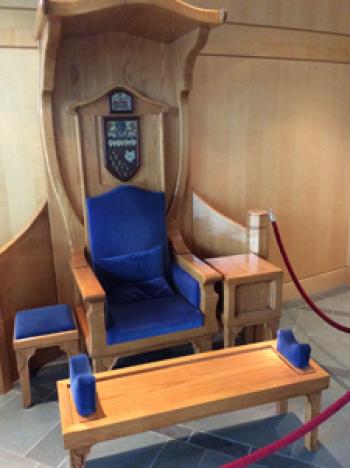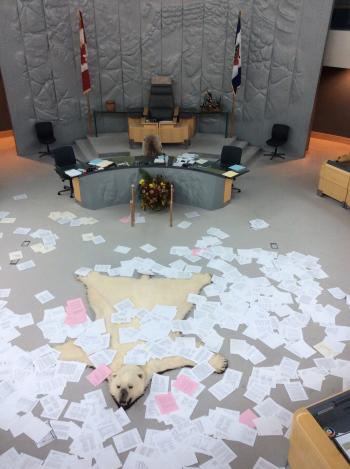Yellowknife in NWT, Canada
This item appears on page 28 of the July 2017 issue.
I have a goal of visiting all the provincial capitals in Canada, and in October 2015 my son, Grant, and I traveled to Yellowknife in the Northwest Territories.
Traveling from Sacramento, California, to Yellowknife and back required two long stopovers in Edmonton, Alberta. Hotel rooms there were expensive, over $245 per night plus shuttle expenses and meals. The flight to Yellowknife from Edmonton International Airport took about two hours.
Legends say that Yellowknife was named for the knives natives used for hunting. Made of copper, they appeared yellow to settlers.
Gold was discovered there in 1898 and again in 1934. There are still a few gold mines northwest of town. Yellowknife’s final salvation was diamonds, discovered in 1991, and they’re still mined about 30 miles north of town.
Of all the towns I’ve ever visited, Yellowknife (pop. 20,000) had the most well developed civil infrastructure for its size — gyms, schools and other civic buildings plus indoor hockey rinks. The roads were smooth and appeared well maintained. There were restaurants of every sort.
Most flights there arrive quite late at night, as ours did. A free airport shuttle took us to our hotel, the Quality Inn & Suites (5010 49 St., Yellowknife, NT, X1A 2N4, Canada; 867/873-2601, www.hlcorp.ca/
yellowknifeinn.aspx), close to town.
Check-in was painless, the room was spacious and well appointed and the beds were comfortable. Food wasn’t available by the time we arrived at 11 p.m., but we had carried goodies from home. In the morning a Continental breakfast was served, but there was no restaurant.
The 3-star hotel’s rate of $120 per night was about average for the area (Arctic Canada). Our room had one double window facing a gully, above which were several shapeless commercial buildings. Overall, if you want to save money, this is a satisfactory hotel.
We had expected temperatures to be much colder than they were. The Internet had predicted high temperatures in October to be about 20°F and lows to -2°, but it was almost 40° when we arrived. It dipped below freezing only once during our 3-day stay.
Winter visitors should consider going later in the year, no sooner than November, if they hope to see the most interesting attractions. These include an ice castle (built every year after the freeze sets in), dogsled rides and an auto drive over the frozen Great Slave Lake ice road to the otherwise isolated Indian village of Dettah.
Our planned dogsled ride was only available in a wheeled sled due to lack of snow, so we decided against it.
Seeing the aurora borealis was another cherished goal, but the aurora-viewing tour we'd booked was canceled. It would have been possible to do the tour two nights earlier. Later, in the publication “Discover Our Yellowknife,” we read that the best months to view the aurora are January through March plus late August or early September.
We went to the yellow pages in the local phone book and called tour agencies until we found one that could provide us a tour of Yellowknife on short notice, since we had no prior booking. I do not recall which agency we ended up with, but our 4-hour day tour cost around $86 for two.
We visited the Bristol Monument (a WWII Bristol airplane on stilts), the Bush Pilots Monument (highest point in town), the Northern Arts & Cultural Centre and the NWT Diamond Centre. We toured Old Town, the Back Bay area (and cemetery), the airplane float dock and a sled dog breeding area.
The most interesting site was the Northwest Territories Legislative Hall. Its annual session had ended the day before we visited, but we got to see an unusual custom that the legislators observe every year.
At the end of each annual session, delegates toss ALL of the papers from their desks into the air and onto the floor of the main legislative room. I found this building to be Yellowknife’s best photo op.
(With the phone book, we also tried to book an aurora tour for that night, but it was overcast.)
We ate dinner at the Red Apple Restaurant (4701 Franklin Ave., Yellowknife; 867/766-3388), the closest restaurant to our hotel. It had a nice Chinese buffet with good food, and the cost was less than $35 for two.
We had exhausted all touring possibilities in town, so on the second full day we decided to ride the local bus. Its routes moved in different directions out of town and around the outskirts. It turned out to be a nice option, and we saw a lot for little money. The fare was CAD2-CAD3 (near $1.50-$2.25) per person.
We later visited a supermarket, Your Independent Grocer (14-4910 50th Avenue), just steps from the bus stop. It was a delightful place to shop, and we saved a little money by buying items we could eat in the room that night or on the plane the next day.
However, we later decided to visit the Black Knight Pub. We took a cab (for both of us, CAD6-CAD7 each way, with credit cards accepted). The pub was crowded and noisy but nice and warm. We both ate well for a total of about CAD70 (near $53) with a few drinks.
All in all, we found Yellowknife to be an interesting and very enjoyable city. The hotel and airfare were somewhat expensive, but restaurant prices were lower than we’d expected.
If you want to visit a unique place that isn’t too foreign or exotic, I highly recommend a visit to Yellowknife.
JAMES B. OERDING
Capay, CA

